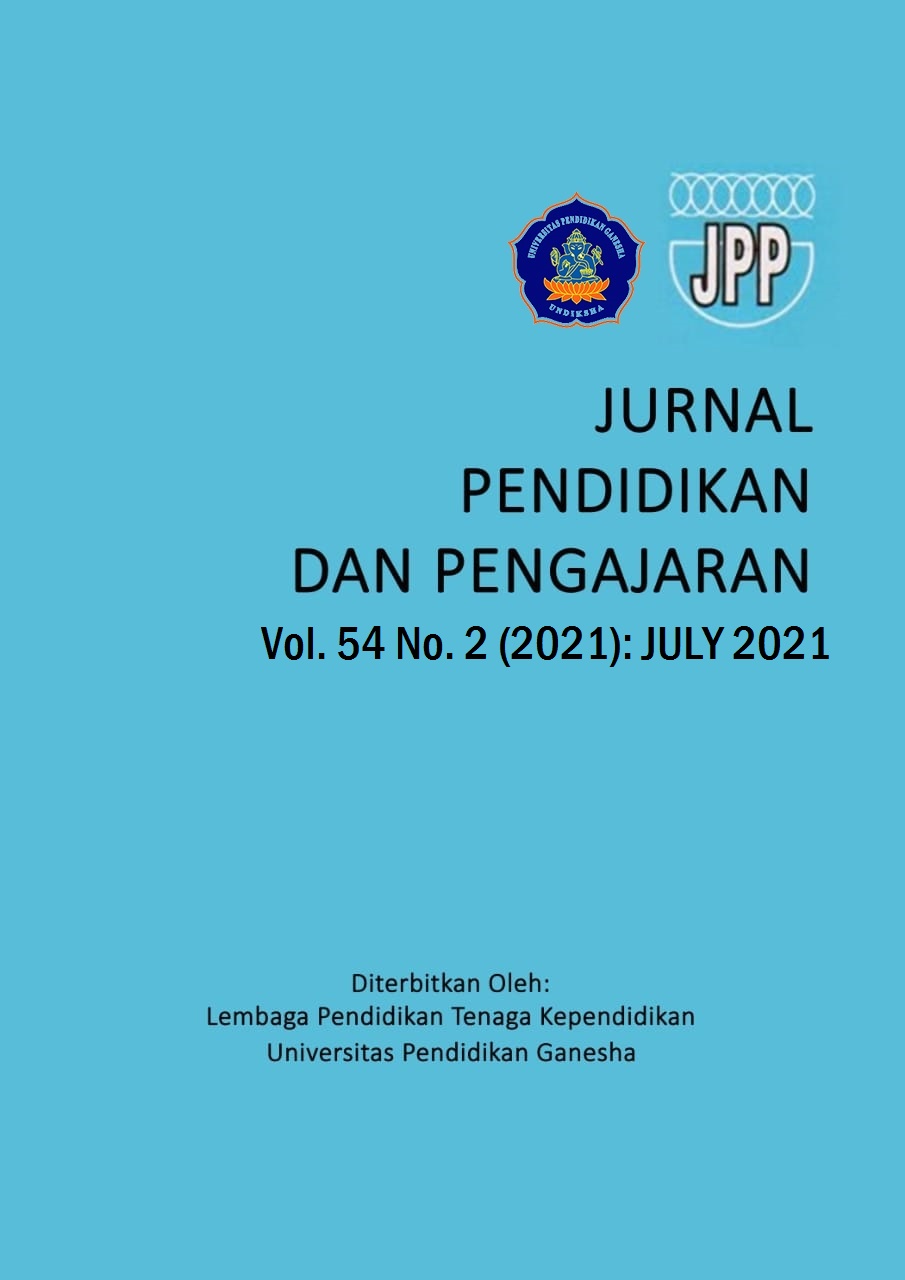The Correlation Between English Language Education Students’ Speaking Anxiety and Their Speaking Fluency
DOI:
https://doi.org/10.23887/jpp.v54i2.28474Keywords:
Correlation, Speaking Anxiety, speaking fluency, FLCASAbstract
This study aims to analyze the correlation between English Language Education (ELE) students’ speaking anxiety and their speaking fluency. This is a quantitative research which consists of 95 students from the 2nd semester as the sample. The data of students’ speaking anxiety were collected through questionnaire namely FLCAS (Foreign Language Anxiety) which was adopted from Horwitz and Cope. While the data of speaking fluency were collected by using speaking test. There are two variables in this research, students’ speaking anxiety as the independent variable and students’ speaking fluency as the dependent variable. The data were analyzed by using SPSS and Pearson Product Moment was used to find out the relationship between the two variables. The result showed that there was a significant and negative correlation between students’ speaking anxiety and their speaking fluency. The significant value is .045<.05 and the value of correlation is -206. The negative correlation in this research indicates that there is an inverse correlation between those two variables. The students obtain low level of anxiety and achieved a high-level score in speaking fluency.
References
Alrefaie, Z., Hassanien, M., & Al-Hayani, A. (2020). Monitoring Online Learning During COVID-19 Pandemic; Suggested Online Learning Portfolio (COVID-19 OLP). MedEdPublish, 9(1), 1–4. https://doi.org/10.15694/mep.2020.000110.1.
Ardington, C., Wills, G., Pretorius, E., Mohohlwane, N., & Menendez, A. (2021). Benchmarking oral reading fluency in the early grades in Nguni languages. International Journal of Educational Development, 84, 102433. https://doi.org/10.1016/j.ijedudev.2021.102433.
Barrot, J. S., & Agdeppa, J. Y. (2021). Complexity, accuracy, and fluency as indices of college-level L2 writers’ proficiency. Assessing Writing, 47, 100510. https://doi.org/10.1016/j.asw.2020.100510.
Bonk, C. J., & Lee, M. M. (2017). Motivations, Achievements, and Challenges of Self-Directed Informal Learners in Open Educational Environments and MOOCs. Journal of Learning for Development, 4(1), 36–57. https://jl4d.org/index.php/ejl4d/article/download/195/188?inline=1.
Dewi, C. (2017). Peningkatan Keterampilan Berbicara Dalam Bermain Drama Melalui Model Pembelajaran Kooperatif Tipe Inside-Outside Circle. JINoP (Jurnal Inovasi Pembelajaran), 3(2), 567. https://doi.org/10.22219/jinop.v3i2.4575.
Haryudin, A. (2016). the Students’ English Speaking Competence Based on Ktsp Curriculum. Eltin Journal, Journal Of English Language Teaching In Indonesia, 4(2), 1–12. http://e-journal.stkipsiliwangi.ac.id/index.php/eltin/article/download/375/623.
Izumi, G. C., Setiyadi, A. B., & Supriyadi, D. (2017). The Study between Students’ Anxiety and Speaking Ability at SMAN 1 Kabupaten Tangerang. U-JET, 6(7). https://core.ac.uk/download/pdf/291528982.pdf.
Lase, D. (2019). Education and industrial revolution 4.0. Jurnal Handayani Pgsd Fip Unimed, 10(1), 48-62. https://jurnal.unimed.ac.id/2012/index.php/handayani/article/view/14138.
Li, H., Peng, M. Y.-P., Yang, M., & Chen, C.-C. (2020). Exploring the Influence of Learning Motivation and Socioeconomic Status on College Using Self-Determination Theory. Frontiers in Psychology, 11, 1–13. https://doi.org/10.3389/fpsyg.2020.00849.
Masuram, J., & Sripada, P. N. (2020). Developing speaking skills through task-based materials. Procedia Computer Science, 172(2019), 60–65. https://doi.org/10.1016/j.procs.2020.05.009.
Megawati, M. (2019). The Correlation Between Students’anxiety And Speaking Skill At Stkip Kusuma Negara Jakarta (A survey research first semester academic year 2018/2019). Scope: Journal of English Language Teaching, 3(2), 117-122. https://journal.lppmunindra.ac.id/index.php/SCOPE/article/view/3384.
Miskam, N. N., & Saidalvi, A. (2019). Investigating English language speaking anxiety among Malaysian undergraduate learners. Asian Social Science, 15(1), 1-7. https://pdfs.semanticscholar.org/10e7/2d0dcf0282a72eae4530173babad88ab9f5a.pdf.
Mitha, W. D., Amri, Z., & Narius, D. (2018). An Analysis of Students’ Speaking Anxiety Faced by the Fourth Semester Students of English Education Study Program of English Departement of Universitas Negeri Padang. Journal of English Language Teaching, 7(3), 1–15. http://ejournal.unp.ac.id/index.php/jelt/article/view/100269.
Putri, M., Ariyani Pedo, V., & Pawestri, N. (2020). Analyzing the Factors Influencing Students’ Fluency in English Speaking Skills: A Case in Bina Nusantara University. ICLLT 2019. https://doi.org/10.4108/eai.12-10-2019.2292184.
Rokach, A. (2014). Loneliness of the marginalized. Open Journal of Depression, 2014. https://www.scirp.org/html/3-2720051_49163.htm?pagespeed=noscript.
Ryan, R. M., & Deci, E. L. (2020). Intrinsic and extrinsic motivation from a self-determination theory perspective: Definitions, theory, practices, and future directions. Contemporary Educational Psychology, 61, 1–31. https://www.sciencedirect.com/science/article/pii/S0361476X20300254.
Shen, M., & Chiu, T. (2019). EFL Learners’ English Speaking Difficulties and Strategy Use. Education and Linguistics Research, 5(2), 88. https://doi.org/10.5296/elr.v5i2.15333.
Simamora, R. M. (2020). The Challenges of Online Learning during the COVID-19 Pandemic: An Essay Analysis of Performing Arts Education Students. Studies in Learning and Teaching, 1(2), 86–103. https://doi.org/10.46627/silet.v1i2.38.
Sun, Y. C., & Yang, F. Y. (2015). I help, therefore, I learn: service learning on Web 2.0 in an EFL speaking class. Computer Assisted Language Learning, 28(3), 202–219. https://doi.org/10.1080/09588221.2013.818555.
Surya, A. M. (2017). A Correlation Between The Students’ Speaking Anxiety and Fluency. State Institutes of Islamic Studies (IAIN) Salatiga.
Wang, Y. H., Chang, M. C., & Liou, J. R. (2020). Comparison of the effectiveness of Taiwanese college and high school students participating in creative contests. Thinking Skills and Creativity, 38. https://doi.org/10.1016/j.tsc.2020.100717.
Wang, Y., Huebner, E. S., & Tian, L. (2021). Parent-child cohesion, self-esteem, and academic achievement: The longitudinal relations among elementary school students. Learning and Instruction, 73, 101467. https://doi.org/10.1016/j.learninstruc.2021.101467.
Yen, Y. C., Hou, H. T., & Chang, K. E. (2015). Applying role-playing strategy to enhance learners’ writing and speaking skills in EFL courses using Facebook and Skype as learning tools: a case study in Taiwan. Computer Assisted Language Learning, 28(5), 383–406. https://doi.org/10.1080/09588221.2013.839568.
Downloads
Published
How to Cite
Issue
Section
License
Authors who publish with Jurnal Pendidikan dan Pengajaran agree to the following terms:- Authors retain copyright and grant the journal the right of first publication with the work simultaneously licensed under a Creative Commons Attribution License (CC BY-SA 4.0) that allows others to share the work with an acknowledgment of the work's authorship and initial publication in this journal
- Authors are able to enter into separate, additional contractual arrangements for the non-exclusive distribution of the journal's published version of the work (e.g., post it to an institutional repository or publish it in a book), with an acknowledgment of its initial publication in this journal.
- Authors are permitted and encouraged to post their work online (e.g., in institutional repositories or on their website) prior to and during the submission process, as it can lead to productive exchanges, as well as earlier and greater citation of published work. (See The Effect of Open Access)





